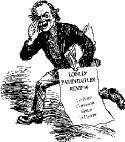
 |
 |

| Thursday, April 25, 2024 |
Miles from the Mainstream |
D.
R. ZUKERMAN, proprietor |
Does The New York Times Support Justifiable Nihilism?
December 5, 2014 -- The New York Times editorial on the post-Ferguson riots, November 26, "The Meaning of the Ferguson Riots, " has not one word of criticism for the rioters. But then, it is apparent from this editorial that The New York Times is incensed that the St. Louis County grand jury did not indict Office Darren Wilson on a homicide charge. The editorial commented that the grand jury decision not to indict Office Wilson "would have generated widespread anger and disappointment in any case." Except the reaction escalated beyond anger and disappointment to looting and destruction. Who is targeted by The New York Times for blame? Robert McCulloch, the county prosecutor. The New York Times found no fault with the rioters who looted and destroyed Ferguson businesses. What did Ferguson business owners do to deserve destruction at the hands of rioters? Apparently, at The New York Times the mayhem and violence after the grand jury decision was announced amounted to justifiable nihilism. The New York Times, LPR concludes, wanted the grand jury to act swiftly by indicting "the white police officer who in August shot and killed Michael Brown, an unarmed black teenager..." This conclusion is based on the invidious speculation set forth in the editorial's third paragraph: "Under ordinary circumstances, grand jury hearings can be concluded within days. The proceeding in this case lasted an astonishing three months. And since grand jury proceedings are held in secret, the drawn-out process fanned suspicions that Mr. McCulloch was deliberately carrying on a trial out of public view, for the express purpose of exonerating Officer Wilson." |
The New York Times omitted the fact that defense counsel does not participate in a grand jury proceeding. Is The New York Times suggesting that prosecutor McCulloch took on himself the role of defense counsel for "the white police offier?" In the editorial's fourth paragraph, after all, The New York Times asserted that "Mr. McCulloch's announcement [of the grand jury decision] sounded more like a defense of Officer Wilson than a neutral summary of the facts had led the grand jury to its conclusion." The New York Times editorial began the fourth paragraph by accusing prosecutor McCulloch of taking "a reckless approach" in announcing the grand jury's decision "late in the evening, when darkness had placed law enforcement agencies at a serious disadvantage as they tried to control the angry crowds that had been drawn into the streets by news that the verdict was coming." The suggestion by The New York Times that the timing of the announcement interfered with police efforts to maintain crowd control is most curious in view of the following assertion constituting the whole of the editorial's sixth paragraph: "In this context, the police are justifiably seen as an alien, occupying force that is synonymous with state-sponsored abuse." The New York Times editorial cited "statistics [that] reflect the fact that many police officers see black men as expendable figures on the urban landscape, not quite human beings." But if, as The New York Times wrote, "the killing of young black men by police is a common feature of African-American life and a source of dread for black parents from coast to coast," is there no concern in the African-American community about black-on-black violence? It is not likely, however, that The New York Times would comment that statistics on black-on-black killings reflect the fact that many black men see other "black men as expendable figures on the urban landscape, not quite human beings."

|
|
